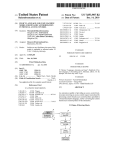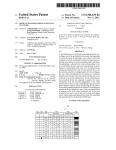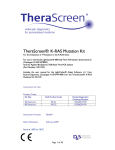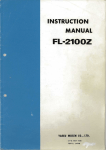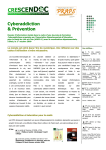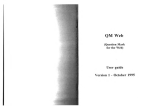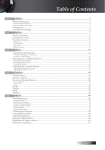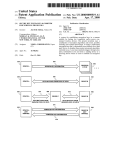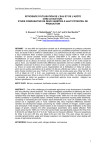Download Composite video signal correction unit for video imaging and video
Transcript
US007652723B1 (12) United States Patent (10) Patent N0.2 Patton et al. (54) (75) (45) Date of Patent: Jan. 26, 2010 COMPOSITE VIDEO SIGNAL CORRECTION 4,851,842 A 7/1989 lwamatsu UNIT FOR VIDEO IMAGING AND VIDEO RECORDING SYSTEMS 4,853,792 A 4,982,191 A 8/1989 Katsuta et a1. 1/1991 Ohta Inventors: David Patton, Louisville, CO (US); Richard Frey, Louisville, CO (US); Edward Brannan, Erie, CO (US) 5,012,330 A 4/1991 Bugni 5,057,932 A 5,086,437 A 5,164,839 A 10/1991 Lang 2/ 1992 Tomita 11/1992 Lang 5,218,449 A (73) Assignee: Video Accessory Corporation, Boulder, Notice: 6/1993 K0 et a1. 5,276,517 A 1/1994 Matsuzawa et 31, Subject to any disclaimer, the term ofthis patent is extended or adjusted under 35 5,280,356 5,341,173 5,422,804 5,627,898 1/1994 8/1994 6/1995 5/1997 U-S-C- 154(1)) by 806 days- 5,644,263 A CO (Us) (*) US 7,652,723 B1 A A A A Hiramatsu Hyeon Clark Washino 7/1997 Clark (21) Appl.No.: 11/082,370 (22) Filed: Mar. 16, 2005 (Continued) Related US. Application Data (60) OTHER PUBLICATIONS Provisional application No' 60/563’751’ ?led on Apr' “Solutions for Genlocking,” VACSync Times, Issue 1 (1995),6pages. 19, 2004, provisional application No. 60/662,914, (Continued) ?led on Mar. 15, 2005. Primary ExamineriTrang U Tran (74) Attorney, Agent, or FirmiSheridan Ross P.C. (51) Int. Cl. H04N 5/16 (52) us. Cl. ..................... .. 348/691; 348/692; 348/695; (2006.01) (57) ABSTRACT 348/525 (58) Field of Classi?cation Search ............... .. 348/691, I 348/692i698, 525, 521, 526527’ 689, 673, 348/677’ 572 See application ?le for Complete Search history (56) U.S. PATENT DOCUMENTS 2 . 1 . t . .d d (b) DC restore circuitry 416 operable to set an average DC voltage of a ?rst portion of the DC-adjusted analog video signal to a ground reference voltage to yield a DC 7/1930 Baggett et 31 10/1981 Geum 1(7); t (a) av1deo 1nput 400 operable to rece1ve a ?rst analog v1deo s1gnal and remove the DC voltage offset component from the video signal to form a DC-adjusted analog video signal; and References Cited 4,215,371 A 4,296,437 A b d. 11 one em 0 1men , a s1gna process1ng sys em 1s prov1 e that mcludes: . . 153M101? et 31' adjusted analog video signal. The DC-restored analog 4’575’755 A 4651213 A 3/1986 sfhogggberger et 31 3/1987 Takimoto video signal is then provided to anAnalog-to-Digital or A/D Tonverter 112 for convers1on 1nto a d1g1tal v1deo slgna ' 4,680,633 A 7/1987 Gerdes et a1. 4,719,584 A 1/1988 Rue et :11. 4,849,906 A 7/ 1989 Chodos et a1. 400 Signal 13 Claims, 8 Drawing Sheets 404 AC Input-7| Coupling D'ff 4033 ti [ I ire/Ell a 4(2 Gain /416 50 DC Control H Control P ReJore l‘uw “"1 Tim? I Signal Output / 516 Video Signal Synch " J Comparison Legend: 1 __> Video Signal Path _ ---> Control Signal Path Signal Path Junction —\ 520 I Vlde° s'gnal ‘ lll?liimgzl comibarison \524 To Monitoring 1 Timing Veri?cation Microprocessor -\ 528 ....... ,1 US 7,652,723 B1 Page 2 US. PATENT DOCUMENTS 5,659,313 5,689,308 5,798,802 5,818,672 5,867,222 5,892,555 5,952,945 5,986,719 5,990,741 5,995,157 5,995,166 5,995,705 6,016,113 6,107,887 6,127,956 6,147,633 6,160,443 6,204,784 6,268,814 6,288,658 6,307,492 6,317,473 6,320,627 6,320,917 6,326,911 6,356,221 6,377,196 6,417,794 6,433,723 6,459,447 6,459,458 6,492,924 6,509,796 6,515,542 6,515,600 6,525,609 6,529,248 6,556,158 6,559,788 6,580,465 6,584,365 6,611,537 6,618,480 6,628,730 > 8/1997 11/1997 8/1998 10/1998 2/1999 4/1999 9/1999 11/1999 11/1999 11/1999 11/1999 11/1999 1/2000 8/2000 10/2000 11/2000 12/2000 3/2001 7/2001 9/2001 10/2001 11/2001 11/2001 11/2001 12/2001 3/2002 4/2002 7/2002 8/2002 10/2002 10/2002 12/2002 1/2003 2/2003 2/2003 2/2003 3/2003 4/2003 5/2003 6/2003 6/2003 8/2003 9/2003 9/2003 Dischert et al. Nayebi Elmis et al. Hilbe Norris et al. Sohn Latham et al. Nakamura Yamamoto et al. Retter et al. Kawano Lang Binder Zucker et al. Agi Ukawa et al. Maalej et al. Hat?eld Kolsrud 6,640,093 B1 6,653,959 B1 10/2003 Wildhagen 11/2003 Song 6,664,907 6,665,308 6,680,680 6,683,554 6,684,065 6,690,311 6,703,958 12/2003 12/2003 1/2004 1/2004 1/2004 2/2004 3/2004 B1 B1 B1 B2 B2 B2 B2 Knepper et al. Rakib et al. Mellot Nikai et al. Bult et al. Lundin et al. Noro 6,704,673 B2 3/2004 McTigue 6,734,817 6,738,002 6,744,320 6,744,832 6,759,904 6,788,230 6,795,496 B2 B2 B2 B2 B2 B2 B1 5/2004 5/2004 6/2004 6/2004 7/2004 9/2004 9/2004 6,798,286 6,798,293 6,803,829 6,816,096 B2 B2 B2 B2 9/2004 9/2004 10/2004 11/2004 Naka et al. Ercan et al. Nguyen et al. Miao Behzad Ahn Soma et al. Dauphinee et al. Casper et al. Duncan et al. Comer et al. Mestdagh et al. Berranger et al. 6,816,204 B2 11/2004 Limberg 6,822,601 B1 11/2004 Liu et al. Stott et al. Scott et al. Stott et al. Gomez et al. 6,831,576 B2 6,833,875 B1 12/2004 Geiger et al. 12/2004 Yang et al. LeChevalier Kolsrud et al. Munoz et al. Randall Okada et al. Balaban OTHER PUBLICATIONS “Solutions for Ground Loop Interferences,” VAC Sync Times, Issue 1 (1994), 4 pages. Kramer Electronics, Ltd., “User Manual Model 104LN” (undated), pp. 1-5. Kramer Electronics, Ltd., “User Manual Distribution Ampli?ers Copley et al. Models VM-1010, VM1015, VM-1021, VM-1042, VM-1044, Nguyen et al. Wang et al. VN-1055, VM-54” (undated), pp. 1-22. Tsyrganovich ............ .. 348/691 “The Electric BulletiNeWest Technology Topping the Security Dealer Chart,” WWW.secdealer.com (Mar. 2003), p. 20. Micronas Preliminary Data Sheet, “VPC 3205C, VPC 3215C, Video Processor Family,” (Oct. 19, 1998), 6251-457-2PD, pp. 1-48. Steensgaard-Madsen Murphy ConeXant Production Data Sheet, “CX25836/7 Video Decoder,” 102267A (Sep. 2004), pp. 1-1-6-6. Graen Behzad Sato ......................... .. 348/689 Blanchard Edens et al. VAC ProSeries Products, “1X4 Equalizing Distribution Ampli?er, FleXPWr, for Belden 8281 Cable,” Video Accessory Corporation (undated), 2 pages. Polley et al. Stott et al. * cited by examiner US. Patent Jan. 26, 2010 Sheet 1 of8 US 7,652,723 B1 100 104 112 ND Converter / Digital Display Enhancement And/Or Recording Device(s) Fig. 1 (Prior Art) US. Patent Jan. 26, 2010 Sheet 3 0f 8 US 7,652,723 B1 100 104 300 Signal Correction -/ Unit / 304 ND Converter Digital Display Enhancement And/Or Recording Device(s) Fig. 3 /'108 US. Patent Jan. 26, 2010 Sheet 4 of8 US 7,652,723 B1 Analog Composite Video Signal IN .i r B mm“H U. m n or H mm. H % C ct m .ww @ ..m. N 4 cI- mm H4 0 mm n m 4% mm w W n 5.m D.AluCmA mm v".M: m VMy“Vo UeSlIf w M be mCl m. .mw. 4ma Fm. mSP m G.mvZ 4Have 08au4 HT M“ .n tE ie n" M .4 m4 w m W we 4 / 0< mD M 0mO dl w m .w.A m < w 1.alm e 2m m .m 0 Sd5 a; te .m 4t DC Restore 2'. Amm}ifrwm nM\" 6‘Ik'mfw _ k m .mD " 5.mDm 2in .Hwh tr d 4A 46 m 4C O . C md 6e a .w r @ M. M 4 01.Alu iOMU T8 5 m m d .m Signal Bypass for PZT Corrected video OUT Legend: Fig. 4 —> Video Signal Path (arrow indicated ?ow) ----> Alternative Video Path (arrow indicates ?ow) > Control Signal Path (arrow lndlcates ?ow) US. Patent Jan. 26, 2010 Sheet 5 of8 US 7,652,723 B1 B N I- 05E; wcozm t> .w9V./8l:. n/.|-cowvmmcmnEo \ <um 59:0 555. u‘7Q“W 6&5 82> 5oi:t.uvz91nEq$“m mcow/mQ\mEo \ 8“,2% Mn$2.52“ 63805.2 >obmEBEoE Mow NP \ ©:~\ \ p.m > Qm nucm j ‘o<lwE0oGm?ocQEgiA1w E8M_£625m3A>:c.30-_wIx3l.o5‘cEmzCcQas?W il5\'965:096:8m0 >55%8£32A>l. m.mt US. Patent Jan. 26, 2010 Sheet 7 of8 R11 3300 ( US 7,652,723 B1 800 c 1|.1F V 1 CTRL CMEXT This _REF -———EVCTRL vs+ 5 R6 3 VINP R5 R7 R9 'v\. ‘TVINM L_ F“ [3 vs - ENBL 4 VOUT E CMOUT VSA R12 C1 3309 1 HF; 7 VGAIN 55 LOGIC _REF Cal C9__ Fig. 7 WW VSA+1 OV X2 l C11 US. Patent Jan. 26, 2010 Sheet 8 of8 US 7,652,723 B1 @@E H302 US 7,652,723 B1 1 2 COMPOSITE VIDEO SIGNAL CORRECTION UNIT FOR VIDEO IMAGING AND VIDEO RECORDING SYSTEMS signal levels. When the analog composite video signal fed to the A/ D converter is degraded, the resulting digital video signal may be distorted. For example, the sync tip 204 may be dis?gured. This distortion may be very slight or severe, depending on the type and level of degradation to the analog CROSS REFERENCE TO RELATED APPLICATION video signal. The most common causes of composite video signal dis tortion in video imaging and video recording systems are as folloWs: Signal loss in the transmission means. This loss may be due The present application claims the bene?ts of US. Provi sional Application Serial Nos. 60/563,751, ?led Apr. 19, 2004, and 60/662,914 ?led Mar. 15, 2005, of the same title and to Patton, et al., each of Which is incorporated herein by this reference. to attenuation, mismatched transmission lines, splitters or other passive devices Within the transmission path. LoW output from the video source. If the signal output from FIELD OF THE INVENTION the video camera or other source is not of su?icient ampli The present invention relates generally to video imaging and video recording systems and speci?cally to video imag meet the desired standard even if the transmission line is tude, the video signal at the input to the A/ D converter may not virtually lossless. Interference due to ground loops. Ground loops result ing and video recording systems including one or more ana log composite video cameras or other video sources, and digital display, enhancement, or recording equipment that 20 incorporates analog to digital conversion means. When the ground potential is different betWeen tWo compo nents Within a video system. This difference in ground poten tial can result in “hum bars” on the video picture caused by 60 HZ commercial poWer, or herringbone interference on the BACKGROUND OF THE INVENTION video picture caused by AM broadcast signals, or a combina tion of 60 HZ and AM broadcast interference that can result in Video imaging systems are used in a broad variety of applications, including telecommunications, entertainment, hum bars, herringbone, blanking, color distortion, or other degradation to the video picture. security monitoring, and the like. Video imaging systems are generally placed in one of tWo categories, namely computer and television. In television applications, baseband video sig DC Offset. A DC voltage may be superimposed on the video signal by the video source or by another device nals can folloW a number of different formats, including the National Television Systems Committee or NTSC standard 25 Within the signal path. If suf?ciently large, the DC offset 30 can result in physical damage to the A/D conversion means and/or to other components Within the system. Even a small DC offset may not cause noticeable deg radation to the video picture in an analog system but may 35 above. Many video components utiliZe AC coupling to eliminate DC offset, hoWever, this approach results in the signal not having a ?xed (e. g., DC) reference, Which is critical to producing an analog composite video signal 40 One exemplary application for the present invention is (the US. and Japan standard), the Phase Alternating Line or PAL standard (the European standard), and the High De?ni tion/ Standard De?nition Digital Television format. In television, there are three basic levels of baseband signal interfaces. In order of increasing quality, they are composite cause errors in the A/ D conversion process as described video (or Color, Video, Blanking, and Sync or CVBS), Which uses one Wire pair, Y/C (or S-video), Which uses tWo Wire pairs, and component, Which uses three Wire pairs. Each Wire pair includes a signal and a ground. Composite signals are the most commonly used analog video interface and combine the brightness information (luma) and the color information (chroma) and the synchronizing signals on just one cable. FIG. 2 depicts the horizontal blanking portion of a typical NTSC composite video Waveform that includes color infor that fully meets the NTSC or PAL speci?cations. video security systems, such as that shoWn in FIG. 1. Such systems typically incorporate a multiplicity of video cameras 100 in continuous operation. The analog composite video signals from these cameras are transmitted via a transmission 45 mation and represents one horiZontal scan line. The signal includes a front porch 200 (Which is the area of the signal betWeen the end of the active video and the leading edge of a sync pulse), the sync pulse or tip 204, (Which provides syn chroniZing timing information), a breeZeWay 208 (Which is the area of the signal representing the time betWeen the rising edge of the synch pulse 204 and the start of a color burst 212, the color burst 212 (or color subcarrier) (Which is 8-10 cycles of the color reference frequency and is positioned betWeen the rising edge of the sync pulse and the start of the active video), and the back porch 216 (Which is the time betWeen the end of the color burst and the start of active video). location most commonly accept baseband composite video 50 recorders. NeW systems and upgrades to existing video secu rity systems typically incorporate one or more digital video recorders, or DVRs, that are designed to accept analog base 55 band video signals. A/D conversion circuitry 112, Which is typically integrated Within the DVR, is designed to Work With either or both of the tWo signal standards (NTSC and PAL). When the input video signal is even slightly degraded and 60 cess may distort the digitiZed video signal, causing the result ant video picture to be signi?cantly Worse in terms of picture In video imaging and video recording systems, analog does not meet the desired standard, the A/D conversion pro ing. While it is desirable that the analog composite video signal input to an analog-to-digital (A/D) converter fully meets the appropriate composite video standard (either the NTSC or PAL standards), in practice the composite video signal is often degraded and does not meet the desired stan dard due to some combination of loW signal output from the video camera, signal loss, interference, or improperAC or DC signals folloWing either the NTSC format or the PAL format. Until recently, most video security systems utiliZed analog composite video signals are often converted to a digital video signal for subsequent enhancement, display, and/or record line 104 (e.g., coaxial cable, tWisted pair, ?ber optics, or radio being the most common transmission line) to a central loca tion Where the video signals may be monitored and are recorded. The video monitors and recorders 108 at the central quality than Would be the case With an analog video recorder. Whereas an analog video recorder might record a useable, though degraded, picture, the picture recorded by the DVR 65 may be distorted to such an extent that much or all of the information is lost. Additionally many DVRs are designed to detect motion Within the video picture based on an algorithm US 7,652,723 B1 4 3 performed on the digitized video signal. If the digitized video (c) setting an average voltage of a ?rst portion of the signal is not an accurate and true representation of the video adjusted analog video signal (the ?rst portion can, for picture captured by the video camera, then the DVR algo example, be one or more of the front porch, breezeWay, color rithm may falsely detect motion When no motion is present, or burst, and back porch) to a ground reference voltage to pro duce a restored video signal. In one con?guration, the restored video signal is converted into a digital video signal Without the problems caused by unWanted DC offsets and loss of the DC reference voltage from the video signal. After removal of the DC offsets and conversely not detect motion When motion is actually present. In the ?rst instance, the DVR Will rapidly ?ll its available digital storage medium resulting in loss of data due to either insuf?cient storage capacity or earlier data being overwritten; in the second instance, the DVR Will not record the desired data at all. The common causes of video signal degradation Within a before DC reference voltage restoration, the DC-adjusted analog video signal may further be passed through a differ ential input to remove ground loop interference. video security system are Well understood by video engineers and other experienced technical people. HoWever, video security system installers typically have neither the necessary training to knoW the causes of video signal degradation, the To compensate for signal losses in the transmission line from the video source and loW poWer output from the video needed test equipment (or training) to identify the speci?c source, the analog video signal, after being passed through the differential input may be further processed by adjustable cause of degradation in a video system installation, nor the knowledge to determine the most cost-effective solution even if the cause of a problem is identi?ed. Additionally, in many installations the level of video signal degradation Would be gain and equalizer circuitry. The adjustable gain circuitry 20 ampli?es all components of the video signal equally While the acceptable With an analog video recorder but results in severe equalizer circuitry ampli?es only higher frequency compo picture degradation, continuous recording, or no recording, nents. When a DVR is installed. There is currently no system able to simultaneously correct many of the common causes of video Applications for this embodiment of the present invention include, but are not limited to, security systems, video imag signal degradation Within a video security system. With the increasing use of digital video recorders in video security 25 Until the present invention, there has been no single device systems, the need for such a solution is immediate and groW that speci?cally corrects for the common causes of composite ing. Another application for the present invention is video imaging systems. Analog composite video cameras are com 30 monly used to capture video pictures that are converted to a digital video signal, then digitally manipulated or enhanced, displayed and/ or recorded. Such applications, Which include medical, satellite and airborne imaging systems, utilize an A/D conversion process as described above, and these sys tems may suffer from the same distortion effects described ing, and radar display systems. 35 above if the analog video signal input is degraded. Since video signal degradation to ensure that the corrected analog video signal nearly meets, or most preferably fully meets, the desired composite video standard prior to anAnalog-to-Digi tal or A/D conversion process Where the resulting digital video signal is enhanced or otherWise digitally manipulated, displayed, and or recorded. The digital replica of the analog video signal can be relatively free of distortion, causing the resultant video picture to be of high quality and providing a high degree of accuracy in motion detection (as more accurate imaging systems typically require the highest possible picture detection of pixel changes betWeen frames). The analog-to resolution, any loss of intelligence due to degradation of the digital orA/ D converter, due to the high standard of the analog analog composite video system is highly undesirable. 40 Another application for the present invention is radar sys tem displays. In many radar systems, the output from the radar receiver is a composite video signal. Many radar sys ciated, signi?cant reductions in video ?le size equate to loWer tems digitally enhance the displayed signal. Such systems utilize an A/D conversion process as described above, and these systems may suffer from the same distortion effects memory requirements, thereby avoiding the need for costly 45 described above if the analog video signal input is degraded. Such display systems are utilized to produce the highest pos sible picture resolution, and the loss of intelligence due to degradation of the analog composite video system is highly 50 undesirable. 55 embodiments and con?gurations of the present invention. These and other advantages Will be apparent from the disclosure of the invention(s) contained herein. are open-ended expressions that are both conjunctive and 60 In one embodiment of the present invention, a signal pro disjunctive in operation. For example, each of the expressions “at least one ofA, B and C”, “at least one ofA, B, or C”, “one or more of A, B, and C”, “one or more of A, B, or C” and “A, B, and/ or C” means A alone, B alone, C alone, A and B together, A and C together, B and C together, and A, B and C reference; component) from the video signal to form an adjusted analog video signal; and conversion process. By providing a compliant video signal to the A/D converter, the resolution Will not be adversely “one or more of. . . an ”, “one or more of. . . or”, and “and/or” cessing method is provided that includes the steps of: (a) receiving a ?rst analog video signal that includes a ?xed (b) removing the ?xed reference (e.g., DC voltage offset While the absolute resolution of the system is constrained by the camera resolution and the recording parameters of the Digital Video Recorder or DVR (Which are typically user de?ned), the resolution can also be impacted by the A/D As used herein, “at least one . . . and”, “at least one . . . or”, The present invention is generally directed to a signal correc tion unit that removes noise and/or corrects various signal errors prior to conversion of the analog video signal into a digital video signal. hard drives or limiting the time that the data can be stored. impacted by the digitization of the video signal. SUMMARY OF THE INVENTION These and other needs are addressed by the various video signal, can create feWer artifacts (noise) and the com pression scheme can Work more e?iciently. As a result, the video ?le size can be reduced signi?cantly. As Will be appre 65 together. The above-described embodiments and con?gurations are neither complete nor exhaustive. As Will be appreciated, other US 7,652,723 B1 5 6 embodiments of the invention are possible utilizing, alone or 412, and Direct Current or DC restore circuitry 416. The A/C in combination, one or more of the features set forth above or input coupling accepts large DC voltage offsets on the input analog composite video signal to accommodate most instal described in detail beloW. lations4even unusual combinations of hardWare that result BRIEF DESCRIPTION OF THE DRAWINGS in an unacceptably high magnitude DC voltage component. The differential input circuitry 404 automatically eliminates or minimizes ground loop interference. The (automatically and/or manually) adjustable gain and EQ circuitry 408 and FIG. 1 is a block diagram of a video imaging system according to the prior art; FIG. 2 depicts a video signal in accordance With the National Television Systems Committee or NTSC format; FIG. 3 is a block diagram of a video imaging system according to an embodiment of the present invention; FIG. 4 is a block diagram of a video signal correction unit according to an embodiment the present invention; FIG. 5 is a block diagram of a video signal correction unit according to an embodiment of the present invention; FIG. 6 is a circuit diagram of the DC restore circuitry according to an embodiment of the present invention; FIG. 7 is a partial circuit diagram of the differential input and adjustable gain and equalizer according to an embodi ment of the present invention; and FIG. 8 is a partial circuit diagram of the adjustable gain and equalizer according to an embodiment of the present inven 412 alloWs for signal optimization, even With signi?cant transmission line loss and/or loW signal levels from the video source. The DC restore circuitry 416 automatically provides the correct DC voltage levels on the composite video signal. By positioning the above subcomponents on each of the video channels, the unit 300 can simultaneously process one or more analog composite video signals being conducted or having components being conducted on multiple channels. As Will be appreciated, A/C coupling 400 is implemented by locating capacitive couplers on each video input/channel. 20 Stated another Way, in each incoming coax transmission line a capacitive coupler is connected in line With each of the center conductor and shield. Because the capacitors Will not pass DC voltage components, such as DC offsets, capacitive coupling Will remove from the composite analog signal any tion. 25 DC offset (or ?xed reference) on the transmission line 104. In a preferred con?guration, A/C coupling removes all of the DC DETAILED DESCRIPTION offset in the input composite analog video signal. Any suit able A/C coupling capacitors may be employed. As depicted in FIG. 3, the video signal correction unit 300 of the present invention is positioned upstream of the A/D converter 112 and digital display enhancement and/ or record The differential input 404 results in a high impedance path betWeen the unit’s input and output signal ground references. 30 ing device(s) 108 (and in the signal pathbetWeen the device(s) 108 and the A/D converter 112) to correct for the common causes of composite video signal degradation before the com 420 betWeen the center conductor and shield of the coax posite video signal is input into the digital display enhance ment and/ or recording device(s). Preferably, the unit 300 is 35 separate from or integral With the A/ D converter. When con ?gured as a separate component, the unit 300 is preferably positioned in close proximity to or adjacent to the converter 112, With a transmission line 304 connecting the signal cor rection unit 300 to the camera 100 (or composite video source). The distance betWeen the composite video source and the signal correction unit 300 may vary betWeen a feW feet to over 1,000 feet, as determined by the user’s require ments. Typically, the signal correction unit 300 and the A/D This high impedance path greatly reduces, and most prefer ably eliminates, undesirable ground loop currents. Speci? cally, the differential input references the input video signal cable. The input connector is not grounded, and the input signal is not referenced to the ground. By isolating the input signal shield from the output signal ground, the ground seg ment of the signal path is broken. The signal input and output impedances are independent of the impedance betWeen the input shield and the output signal ground and are selected to 40 match the impedance of the transmission lines (typically coax cable) 104 and 304 respectively. Preferably, the differential input impedance ranges from about 50 to about 909, With an impedance of about 759 being most preferred. The adjustable gain circuitry 408 alloWs for adjustment of converter 112 are electronically adjacent to one another and even more preferably are mounted in the same equipment the video signal amplitude (or IRE levels). The adjustable gain circuitry 408 can be any ampli?er that ampli?es equally rack. More preferably, the cumulative signal loss in the com all of the video signal frequency components by a desired posite video signal along transmission line 304 before being gain. This is intended to restore the sync tips 204 to the proper input into the A/D converter and digital display enhancement and/ or recording device(s) 108 is no more than about 0.25 dB magnitude (or IRE level). Preferably, the signal poWer is 50 and even more preferably no more than about 0.1 dB. The signal transmission line may be any conductor, With coaxial or tWisted pair being preferred. Although the preferred embodiment is discussed With ref erence to NTSC-type analog composite video signals, it is to be understood that the embodiment can operate equally With 55 HDTV component video signals, Red Green Blue or RGB component video signals, Video Graphics Array orVGA-type faces. The subcomponents of the signal correction unit 300 are depicted in FIG. 4. The unit 300 includes Alternating Current or A/ C coupling 400, differential input circuitry 404, adjust able gain circuitry 408, adjustable Equalizer or EQ circuitry 4 db). The adjustable EQ circuitry 412 alloWs for frequency dependant adjustment of the video signal amplitude and is used to compensate for the high-frequency roll-off that is inherent in many types of transmission lines, particularly, but not limited, to coaxial cable and tWisted pair. The adjustable other types of video signals, such as PAL-type video signals, video signals, and Extended Graphics Array or XGA-type signals over any suitable video interface, including not only composite signals but also Y/C and component video inter adjusted by an amount ranging from about 0.5>< to about 4x (or from about —3 db to about 6 db) and even more preferably from about 0.5>< to about 2.5>< (or from about —3 db to about 60 EQ 412 may be any ampli?er that differentially ampli?es only the higher frequency video signal components (e. g., the components have a frequency greater than about 1 MHz). In one con?guration, the amount of ampli?cation is frequency independent (or provides ?xed or constant gain) for frequen cies greater than a selected frequency. In another con?gura 65 tion, the amount of ampli?cation is frequency dependent (or provides variable gain) for frequencies greater than the selected frequency. As Will be appreciated, the losses along US 7,652,723 B1 7 8 certain transmission lines, such as a coax, are frequency the video signal is at DC ground potential. Preferably, the DC restore circuitry 416 restores the front porch 200 (and the breeZeWay 208 and back porch 216) (or the 0 volt reference point(s)) to the proper position. When the AC coupling 400 dependent. For example, 1,000 feet of coaxial cable Will provide relatively loW losses for 2 MHZ signals but much higher losses for 40 MHZ signal components. The latter ampli?er con?guration is intended to provide a frequency dependent gain that matches the signal losses up to about 100 MHZ. With reference to NTSC signals, the adjustable EQ 412 is intended to adjust the high frequency components of the video signal to the appropriate magnitude (or IRE level), and removes any DC offset from the video signal, it effectively removes the DC reference voltage (represented by the front porch 200) from the video signal. DC restore circuitry 416 restores the true Zero volt DC reference to the signal. Thus, the presence of the DC restore circuitry 416 is preferred WhenAC coupling 400 is employed. the amount of ampli?cation is based, at least in part, on the previously adjusted gain of the adjustable gain circuitry. The In a preferred con?guration shoWn in FIG. 6, the DC adjustable gain is set so that the sync tip 204 is at the correct restore circuitry 416 comprises a high ?delity ampli?er 700 amplitude. For signal components having a frequency above about 1 MHZ, the signal ampli?cation preferably ranges from pling capacitor to provide level-shifting of the video output and a sample-hold sWitch circuit 704 using an external cou about 0.5>< to about 4x (or from about —3 dB to about 6 dB) and even more preferably from about 0.75>< to about 2x (or from about —1.3 dB to about 3 dB). The differential input 404 and adjustable gain and EQ 408 and 412 may each be any suitable circuitry, such as an inte grated circuit. In a preferred implementation, the differential input 404 and adjustable gain and EQ 408 and 412, respec 20 tively, are embodied in the EL9110TM integrated circuit manufactured by Intersil Corporation. The integrated circuit is a single channel differential receiver and equaliZer. It con tains a high speed differential receiver With ?ve program mable poles. The outputs of the pole blocks are summed into an output buffer. The equaliZation length can be set With the voltage on a single pin. The gain can be adjusted up or doWn by 6 dB using a VGAIN control signal. Additionally, a further 6 dB of gain can be sWitched in to provide a matched drive ration, the circuit functions by setting, during the horiZontal 25 30 A single input voltage can be used to set the compensation levels for the required length of transmission line. The equivalent circuitry of this integrated circuit is shoWn 35 voltage (0 to 1 Volt) to set equaliZation), VINP (Which is the positive differential input), VINM (Which is the negative dif 40 signal) When the sync tip 204 is detected. Although the sync tip may be detected using any voltage level of the sync pulse at or beloW the 50% level 250 (-20 IRE), the sync tip is preferably detected When the sync pulse voltage hits the 50% level 250 (or —20 IRE). The sync separator 708 sends the hold signal to pin 4. After a predetermined time (or duration of the voltage present at the inputs), VGAIN (Which is the control voltage to set the overall gain (the control voltage is from 0 to 1 Volt)), LOGIC_REF (Which is the reference voltage for all logic signals), X2 (Which is the logic signal (loW—gain:1 and back porch 216) to 0 Volts (or 0 IRE) or ground. The hold signal sent to pin 4 goes loW during the color burst, and it is during that time that the average DC voltage is forced to ground. Although any DC restore circuitry may be used, the preferred DC restore circuitry is the ZXFV4089TM integrated circuit manufactured by ZETEX. The sample-hold sWitch circuit 704 is time gated by a sync separator 708 that is capacitively coupled to the line 432 carrying the ampli?ed and equaliZed video signal. The sync separator 708 samples the ampli?ed and equaliZed video signal and generates and sends the timing pulse (or the hold various leads, including CTRL_REF (the reference voltage for the Vgal-n and VCTRL pins), VCTRL (Which is the control ferential input), VS- (Which is —5 Volts to core of the chip 800), CMOUT (Which is the output of the common mode sync, the average DC voltage during the color burst to Vref, Which is at pin 3. Setting this to ground (0 Volts) forces the average DC voltage during the color burst (and as a result the into a cable. The circuit has a bandWidth of about 150 MHZ. in FIGS. 7-8. Referring to FIG. 7, the chip 800 is connected to signal such that a time-gated sample of the Waveform is set to be equal to an external reference voltage (usually 0 Volts). A buffered Transistor Transistor Logic/Complementary Metal Oxide Semiconductor or TTL/CMOS logic input signal con trols the sWitch 710. The gain is set externally by tWo resis tors. The sample-hold circuit may be gated on during part of the front-porch, color burst, and/or back-porch interval of the video signal Waveform. The video Waveform is then ?xed for the remainder of the line-scan interval. In a preferred con?gu 45 hold signal), the hold signal goes loW as noted above. The predetermined time is measured from the time that the sync tip is detected and is selected so that the hold signal goes loW before or during the color burst. The predetermined time is typically about 5 .06 microseconds. The capacitor 750 is a DC ENBL (Which is a logic signal to enable the pin Where loW is disabled and high is enabled), VS+ (Which is +5 Volts to the core of the chip 800), and CMEXT (Which is the logic signal to enable CM range extension Where active is high). The components of chip 800 are shoWn in FIG. 8. The chip 50 blocking capacitor (that blocks all of the DC voltages in the 800 comprises a common mode range extended module 904, 55 high—gain:2), 0 V (Which is 0 Volt reference for the output voltage), VSA- (Which is —5 Volts to the output buffer), VOUT (Which is the single-ended output voltage referenced to pin 10), VSA+ (Which is +5 Volts to the output buffer), video signal) as the sync separator may be damaged by a negative DC voltage. After passing through the capacitor, the signal is suitably adjusted so its voltage does not go negative. In a preferred implementation, the AC coupling 400, dif an input ampli?er 908, a loW frequency boost ampli?er 912 and high frequency equaliZing boost module 916, a control Analog Signal Processor or ASP 920, a gain ASP 924, and adjustable EQ circuitry 412, and DC restore circuitry 416 are located relatively close to one another. Preferably, these cir cuit elements are electrically adjacent, and even more prefer ably are integrated onto a single circuit board to minimiZe additional ampli?ers 928, 932, and 934, and bias circuitry 938. The common-mode extension system is preferably dis 60 problems. voltage of the burst interval (or the voltage level of the front porch 200, breeZeWay 208, and/or back porch 216) as com front porch 200, breeZeWay 208, and/or back porch 216) of signal losses, simplify impedance matching betWeen circuit elements, and minimiZe undesirable radiation and grounding connected due to the use of A/C coupling 400. The DC restore circuitry 416 measures the average DC pared to a ground reference and generates a correction voltage to ensure that the blanking portion (or the voltage level of the ferential input circuitry 404, adjustable gain circuitry 408, 65 As shoWn in FIG. 4, the input video signal may be prelimi narily fed to a bidirectional signal coupler 436, Which sends pan, tilt, and Zoom (PZT) commands “upstream” from the signal correction unit 300 output 440 to the composite video source 100, typically a video camera. The bidirectional cou US 7,652,723 B1 10 FIG. 5 depicts a signal processing unit 500 according to a preferred embodiment of the present invention. The basic elements of the signal processing unit 500 are shoWn inside the heavy dotted box 512. A process timing signal 516 is extracted prior to the signal output. Note that the location in pler 436 on the signal correction unit 300 output 440 routes the PZT command signals around the various signal process ing components 400, 404, 408, 412, and 416 of the signal correction unit 300, to the output bidirectional signal bypass 444 and to the coupler 436. The PZT signal originates from the video signal ?oW Where this timing signal is extracted is not limited to the position shoWn. The process timing signal 516 provides needed signal location information to the video signal sync amplitude comparison module 520, the video signal burst amplitude comparison module 524, and the tim the terminating equipment, typically a DVR or dedicated PZT control device. As Will be appreciated, routing the PZT sig nals through the unit 300 can substantially degrade not only the quality of the processed video signal but also the PZT command signal quality. ing veri?cation microprocessor 528. The video signal sync amplitude comparison module 520 Depending on the video system con?guration, the output of the DC restore circuitry 416 may either be the signal 448 outputted by the video signal correction unit 300, or may be the signal 452 inputted to a distribution ampli?er (DA) 456. The DA 456 generates a multiplicity of nearly identical, and preferably identical, ampli?ed output signals so that the out put signal is replicated on a multiplicity of output connectors, enabling the user to send the identical signal to multiple locations or video system components. In one con?guration, the amplitudes of the multiple ampli?ed output signals measures the amplitude of the sync pulse 204 and sends a correction signal, if needed, to the gain control circuitry 408 and the monitoring device 504. The video signal burst ampli tude comparison module 524 measures the amplitude (or peaks) of the black burst portion of the video signal, and sends a correction signal, if needed, to the EQ control circuitry 412 and the monitoring device 504. The timing veri?cation micro 20 46011,!) are each Within about 98% of the amplitude of the input signal 452. Preferably, the distribution ampli?er 456 is con?gured to provide a gain of from about 1.0x to about l.05>< (or of from about 0 dB to about 0.2 dB) With unity gain being most preferred. In a typical implementation, a 1 x2 DA is often required so that the signal from the video source can be routed redundant poWer supply circuitry for increased reliability. This unit may also include a monitoring and control device to sWitch to or activate the redundant poWer supply circuitry When the primary poWer supply means does not meet prede to tWo different devices, such as a video monitor and a DVR, simultaneously and Without any loss of signal. As shoWn in FIG. 4, the gain and/or EQ 408 and 412 may be adjusted manually, automatically, or a combination thereof. Automatic adjustment can be effected by monitoring the output of each video channel, and verifying that the ver 30 termined performance speci?cations. Alternatively, the unit may include an uninterruptible poWer supply (UPS) With alarm means to indicate When the UPS is operating from battery backup. tical interval, synch tip amplitude, and/or color burst ampli The above ?gures are not intended to limit the functions of the signal processing unit to those elements shoWn, or to indicate that all of these functions are required in every embodiment of the present invention. A number of variations and modi?cations of the invention can be used. It Would be possible to provide for some features of the invention Without providing others. For example in one alternative embodiment, the various modules or components in the unit 300 are implemented in hardWare (such as a logic circuit) and/or in softWare. In another alternative embodiment, the signal How is not restricted to the sequence shoWn. Other con?gurations of the tude of the output signal meets the desired composite video speci?cation or standard. The automatic control is effected by a signal processing unit 500 coupled With a monitoring device 504 and one or more feedback indicators 508. The unit 500 controls automatically the gain and EQ circuitry using a con trol feedback loop. The operation of the unit 500 (e.g., the settings of the gain and EQ circuitry, the control signals generated by the unit 500 and the DC restore circuitry 416) is monitored by the device 504, and the device 504 veri?es that the post-processed signal meets the desired video standard. The monitoring unit 504 Will generate a control signal to the indicator(s) 508, Which provides con?rmation to the user that the processed signal at the output 440 of the video signal correction unit 300 meets speci?ed parameters/desired stan dard. The indicator(s) 508 may be visual, such as LEDs or a LCD screen display, or electrical, such as dry contact sWitch closure, or both and may be a local display, or a device for remote monitoring, or both. processor 528 measures the vertical timing intervals and sync tip timing, and compares these measured times to a pre determined time standard. An error signal, that is proportional to the deviation from the desired time standard, is generated and sent to the monitoring device 504. In any of the above con?gurations, the unit 300 can include same functions are possible, and such variations Will be rec ogniZed by video equipment design engineers. 50 The present invention, in various embodiments, includes components, methods, processes, systems and/or apparatus substantially as depicted and described herein, including vari ous embodiments, subcombinations, and subsets thereof. Those of skill in the art Will understand hoW to make and use the present invention after understanding the present disclo sure. The present invention, in various embodiments, includes providing devices and processes in the absence of In one con?guration, the signal processing unit 500 mea sures the sync tip voltage level and adjusts the gain, typically With a control voltage, so that the sync tip level meets the signal standard (for example, —40 IRE for an NTSC video signal). The unit 500 also measures the color burst amplitude of the signal level and adjusts the EQ, typically With a control voltage, so that the color burst level meets the signal standard (for example, +/—20 IRE for an NTSC video signal). The items not depicted and/ or described herein or in various embodiments hereof, including in the absence of such items as may have been used in previous devices or processes, e. g., for improving performance, achieving ease and\or reducing signal processing unit 500 determines the gain and EQ cor rection voltages and may incorporate a microprocessor that cost of implementation. The foregoing discussion of the invention has been pre sented for purposes of illustration and description. The fore measures signal timing and generates one or more control going is not intended to limit the invention to the form or voltages that are sent to the adjustable gain and EQ 408 and 412. The signal processing unit and monitoring device may 65 forms disclosed herein. In the foregoing Detailed Description for example, various features of the invention are grouped be, but are not required to be, combined and controlled by a together in one or more embodiments for the purpose of single microprocessor. streamlining the disclosure. This method of disclosure is not US 7,652,723 B1 11 12 5. The system of claim 1, Wherein the DC-adjusted com to be interpreted as re?ecting an intention that the claimed invention requires more features than are expressly recited in posite analog video signal comprises ground loop interfer ence and further comprising betWeen the video input and DC each claim. Rather, as the following claims re?ect, inventive aspects lie in less than all features of a single foregoing disclosed embodiment. Thus, the folloWing claims are hereby incorporated into this Detailed Description, With each claim restore circuitry: (d) a differential input to remove at least mo st of the ground loop interference from the DC-adjusted composite ana log video signal. standing on its oWn as a separate preferred embodiment of the invention. Moreover, though the description of the invention has included description of one or more embodiments and certain 10 variations and modi?cations, other variations and modi?ca 6. The system of claim 5, further comprising betWeen the differential input and DC restore circuitry: (e) adjustable gain circuitry operable to amplify at least a ?rst part of the DC-adjusted composite analog video tions are Within the scope of the invention, e.g., as may be signal to a selected level, the at least a ?rst part of the Within the skill and knowledge of those in the art, after under standing the present disclosure. It is intended to obtain rights Which include alternative embodiments to the extent permit DC-adjusted composite analog video signal comprising 7. The system of claim 6, further comprising after the ted, including alternate, interchangeable and/ or equivalent adjustable gain circuitry and before the DC restore circuitry: structures, functions, ranges or steps to those claimed, Whether or not such alternate, interchangeable and/ or equiva lent structures, functions, ranges or steps are disclosed herein, (f) an adjustable equaliZer to amplify at least a second part and Without intending to publicly dedicate any patentable subject matter. a sync tip. of the DC-adjusted composite analog video signal only 20 is set during a ?rst time interval and the DC restore circuitry is further operable during a second non-overlapping time What is claimed is: interval, to stabiliZe at least a second portion of the DC 1. A signal processing system, comprising: (a) a video input operable to receive at least a ?rst compos adjusted composite analog video signal, Whereby the DC 25 ite analog video signal, the ?rst composite analog video restored composite analog video signal is at DC ground component, the video input including Analog Circuit or potential and at least a second portion of the DC-restored A/C coupling operable to remove at least most of the DC 30 analog video signal, the ?rst composite analog video (b) DC restore circuitry operable to set an average DC voltage of at least a ?rst portion of the DC-adjusted 35 40 ing said Sync Separator coupled to a buffered logic device operable to set an average voltage during the color burst portion of the DC-adjusted composite analog video signal; and (c) anAnalog-to-Digital or A/D converter operable to con 45 vert the DC-restored composite analog video signal into a composite digital video signal. 2. The system of claim 1, Wherein, in the removing step (b), the DC voltage offset component is removed by capacitive coupling. Sync Separator coupled to a buffered logic device oper able to set an average voltage during the color burst 50 3. The system of claim 1, Wherein the at least a ?rst portion vert the DC-restored composite analog video signal into a composite digital video signal. 10. The system of claim 9, Wherein the DC-adjusted com comprises an ampli?er to amplify the DC-adjusted composite analog video signal, a time-gated sample-hold sWitch circuit to sample the DC-adjusted composite analog video signal, a posite analog video signal comprises ground loop interfer ence and further comprising betWeen the video input and DC restoring means: (d) differential input means for removing at least most of sWitch controller to control the sWitch setting in the sample hold sWitch circuit, and a coupling capacitor to provide level 60 the ground loop interference from the DC-adjusted com posite analog video signal. Wherein, during a ?rst time interval, the sample-hold circuit samples the DC-adjusted composite analog video signal, Wherein the average DC voltage of the sample-hold circuit’s sample of the at least a ?rst portion of the DC-adjusted com sample-hold circuit is set to hold. portion of the DC-adjusted composite analog video sig nal; and (c) an Analog-to-Digital or A/D converter operable to con burst of the video signal. 4. The system of claim 3, Wherein the DC restore circuitry posite analog video signal is set to the reference voltage, and Wherein, during a second non-overlapping time interval, the (b) DC restoring means for setting an average DC voltage of at least a ?rst portion of the DC-adjusted composite analog video signal to a reference voltage, the reference voltage being equal to ground and the at least a ?rst portion comprising at least one of the front porch, breeZeWay, color burst, and back door to yield a DC restored composite analog video signal, the DC restore circuitry including a Sync Separator operable to send a hold signal during a color burst portion of the DC-ad justed composite analog video signal, and including said of the DC-adjusted composite analog video signal is the color shifting of the DC-restored composite analog video signal, signal comprising a Direct Current or DC voltage offset component, and removing at least most of the DC volt age offset component from the video signal to form a DC-adjusted composite analog video signal; send a hold signal during a color burst portion of the DC-adjusted composite analog video signal, and includ composite analog video signal is not at DC ground potential. 9. A signal processing system, comprising: (a) video input means for receiving at least a ?rst composite signal; composite analog video signal to a reference voltage, the reference voltage being equal to ground to output a DC-restored composite analog video signal, the DC restore circuitry including a Sync Separator operable to restore circuitry provides a DC-restored composite analog video signal in Which the at least a ?rst portion of the DC signal comprising a Direct Current or DC voltage offset voltage offset component from the ?rst composite video signal to form a DC-adjusted composite analog video at frequencies above a selected frequency. 8. The system of claim 7, Wherein the average DC voltage 65 1 1. The system of claim 1 0, further comprising betWeen the differential input and DC restore circuitry: (e) adjustable gain means for amplifying at least a ?rst part of the DC-adjusted composite analog video signal to a selected level, the at least a part of the DC-adjusted composite analog video signal comprising the sync tip. US 7,652,723 B1 13 14 12. The system of claim 11, further comprising after the adjustable gain means and before the DC restoring means: (f) adjustable equalizer means for amplifying at least a posite analog Video signal, the at least a second portion com prising the sync tip, Whereby the DC restoring means pro Vides a DC-restored composite analog Video signal in Which at least a ?rst portion of the DC-restored composite analog Video signal is at DC ground potential and at least a second second part of the DC-adjusted composite analog Video signal only at frequencies above a selected frequency, Wherein the at least a second part comprises the color burst but excludes the sync tip. 13. The system of claim 9, Wherein the DC-restoring means stabiliZes at least a second portion of the DC-adjusted com portion of the DC-restored composite analog Video signal is not at DC ground potential. * * * * * UNITED STATES PATENT AND TRADEMARK OFFICE CERTIFICATE OF CORRECTION PATENT NO. : 7,652,723 B1 Page 1 of1 APPLICATION NO. : 11/082370 DATED : January 26, 2010 INVENTOR(S) : Patton et a1. It is certified that error appears in the above-identified patent and that said Letters Patent is hereby corrected as shown below: On the Title Page: The ?rst or sole Notice should read - Subject to any disclaimer, the term of this patent is extended or adjusted under 35 U.S.C. 15 4(b) by 1290 days. Signed and Sealed this Twenty-third Day of November, 2010 David J. Kappos Director of the United States Patent and Trademark Oj?ce


















